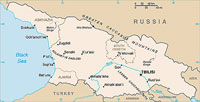Empty Towns, Destruction in Georgia Show `Everyone Is to Blame’

(Bloomberg – Lucian Kim – August 18, 2013) Twenty-five miles on the main road west from the Georgian capital of Tbilisi, Russian soldiers argue with a mercenary as refugees trudge along in the summer heat.
The scene, reminiscent of the Balkans in the 1990s, is the result of a 10-day conflict over the breakaway Georgian region of South Ossetia. The fighting has turned towns and villages between Tbilisi and the Russian border into empty shells, most of their inhabitants having fled to safety.
“Everyone is to blame,” said Jumber Garuzashvili, 33, on his way to join his wife and three children in Tbilisi. With a rucksack and clutching a child’s violin case, he had already walked for three days. “My son must learn the violin,” he said.
The military conflict over South Ossetia has displaced more than 100,000 people and cemented the ethnic divide between Ossetians and Georgians. While the distance between Tbilisi and Vladikavkaz in Russian North Ossetia is only 100 miles (161 kilometers), the two areas are divided by the towering Caucasus Mountains, mutual suspicion and now the Russian army.
Russian President Dmitry Medvedev said his troops will today begin pulling out of areas they invaded in Georgia. His statement came after the U.S. and other western governments demanded the Kremlin honor a cease-fire that only allows Russian troops in the pro-Moscow breakaway regions of South Ossetia and Abkhazia.
The incursion into Georgia began on Aug. 8, after Georgian President Mikheil Saakashvili tried to take control of South Ossetia, where most residents hold Russian passports. Russian peacekeepers have been in South Ossetia since the region gained de facto independence from Georgia in a war in the early 1990s.
Russian Flag
A Bloomberg News reporter was among a group of journalists traveling with a Russian military escort north from Tbilisi, into South Ossetia and through the Roki Tunnel, a 2.5-mile passage that links with the Russian North Ossetia.
Some 25 miles from the outskirts of Tbilisi, Russian troops were hunkered down along the road with armored vehicles, flying the Russian tricolor of white, blue and red. A handful of Russian soldiers stood in the road to control the traffic.
An irregular fighter in tennis shoes and mismatched fatigues looked on, cradling a Kalashnikov. A white armband identified him as one of an unknown number of pro-Russian “volunteers,” who poured into Georgia after the fighting started. The Georgians have accused such irregulars of pillaging towns and villages.
He wore a U.S.-military style cap, and an American helmet — now used by Georgian soldiers — dangled from his belt.
Gold Teeth
The fighter said he was from Russia’s nearby Muslim region of Dagestan and that many other volunteers had come down from Chechnya and other Russian regions in the Caucasus.
One of the Russian officers approached the fighter and ordered him not to mingle with his troops. An exchange of obscenities followed. The Dagestani held his ground, his defiant grin exposing a row of gold teeth.
Further along the road, the city of Gori, occupied by advancing Russian troops last week, was eerily quiet, with only elderly people and a few men on the street.
The remaining stretch to Gori still wasn’t fully under Russian control. Fields on the approach to the town, Soviet leader Joseph Stalin’s birthplace, were burning.
There were a number of Russian encampments with trucks and armor in full display. The Georgian flag on the administrative building in the town center was flying at half-mast, in accordance with the three days of mourning declared by the government in Tbilisi. Shops were shuttered and intact.
“Cossacks, Ossetians are stealing everything,” said Garuzashvili, a Gori native.
On to Tskhinvali
Less than an hour’s drive to the north is Tskhinvali, the South Ossetian capital where fighting began after Georgian forces took the city on Aug. 8 following a night of heavy bombardment.
“We keep on finding burned bodies and remains of people in the villages that were under attack,” said Mikhail Minzaev, the interior minister of South Ossetia’s self-declared government. The estimated number of civilian dead on the South Ossetian side now exceeds 2,100, he said. Georgia’s government has disputed that death estimate as “propaganda.”
Electricity and water hadn’t been restored to the few residents of Tskhinvali who remained on the weekend.
Most houses had broken windows and were either pockmarked by bullets or gutted by shelling. A golden statue of Ossetian linguist Vasily Abaev in the town center had its face blown off. The pro-Russian locals are bitter.
“The Georgians already did this to us in 1918,” said, Tushar Gabaraev, 68, sitting in the ruins of his home. That was the year Georgia achieved three years of independence before the country was reincorporated into the Soviet Union in 1921.
Survived in a Cellar
“We want to be independent from Georgia and part of Russia,” said Madina Safanova, a 29-year-old artist who like most residents survived the bombardment in a cellar. “Our boys didn’t spill their blood for nothing.”
Only a few miles out of Tskhinvali, the road passes through a village that once was inhabited by ethnic Georgians.
It was abandoned after the attack, with every house burned out or destroyed. Someone had painted the words, “Onwards to Tbilisi” on one of the walls.
Another 10 miles and lights were twinkling from farmhouses set against craggy black peaks. Column after column of Russian supply trucks and armored vehicles descended from the mountain border crossing, trundling back the other way, into Tskhinvali.
Article ©2013 BLOOMBERG L.P. ALL RIGHTS RESERVED. Article also appeared at http://www.bloomberg.com/apps/news?pid=newsarchive&sid=ayvE6rQoQ0Yo
